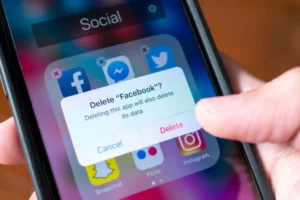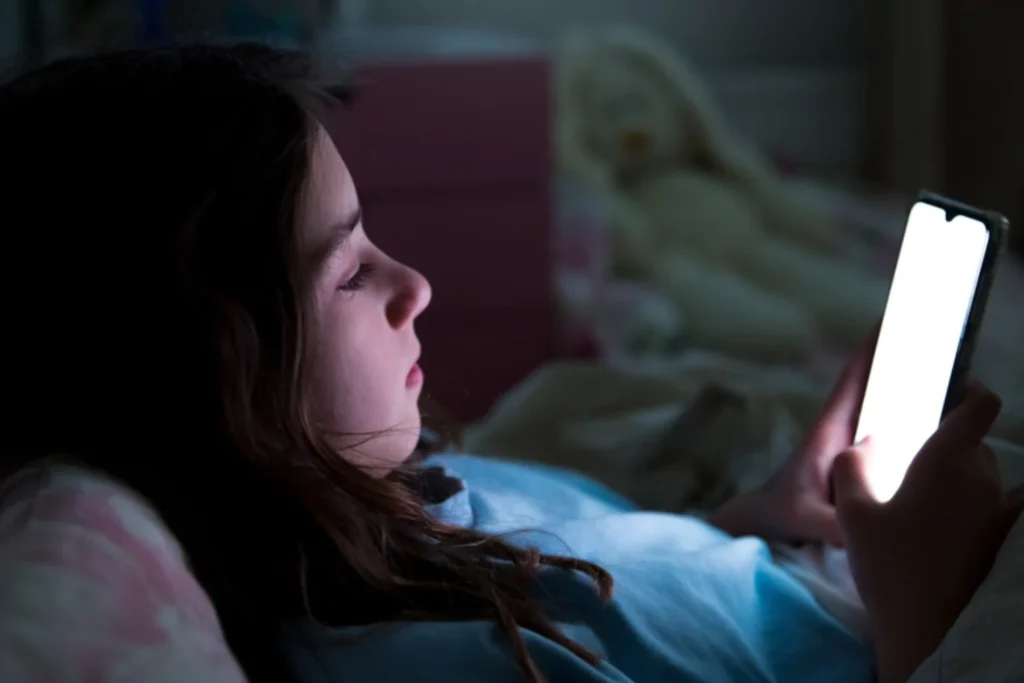
I Quit Social Media for a Week … and My Marriage Thrived
Have social media become a time waster that is interfering with your relationship with your spouse? Consider disconnecting.

Teenagers know social media is a problem. What they don’t know is how to live without it. That’s where you come in.
Estimated reading time: 9 minutes
I have a confession to make: I’m not on social media.
Okay, so maybe that’s not so much a confession as it is just a fact. I still browse Pinterest for knitting ideas and use YouTube for various how-tos when I’m working on a project. But when it comes to posting pics on Instagram, commenting on a family member’s Facebook post or mindlessly scrolling through TikTok videos, I’m not among the masses.
I don’t even have accounts on those websites anymore. I did the full delete (which you can read more about at Plugged In: “Deleting My Instagram Was Nearly Impossible – But I Did It Anyway”). So there’s no temptation to “unfreeze” my account and hop back on, either.
I’ve been social media free for a little over two years now. And I gotta say, I don’t miss it. Every now and then, my sisters will send a funny video they found online, and I wonder if I should be sending them videos, too. But then the unfortunate reality check hits me: They likely spent at least half an hour sifting through internet slop to find that one nugget worth sending to our family chat.
It’s unfortunate because—according to an ongoing investigation of TikTok by 13 state attorneys general—it can take as little as 35 minutes to become addicted to social media. So that half-hour my siblings spent searching for that funny video will likely contribute to even more hours wasted in the future.
Of course, I’m not saying that every person who spends half an hour killing time on social media will become addicted to it. But I remember what it was like for me before I quit. I’d come home from work (or school, when I was younger), crash on the couch and pull out my phone. I’ll just decompress for a bit and then do something, I’d tell myself. But it was never “a bit.” Five minutes quickly turned into 30. Half an hour soon stretched into an hour. And by the time I bothered to check what time it was, I usually had a crick in my neck and zero motivation to do any of the things I had said I would do.
That’s why I got on social media: I wanted to be entertained. If I had used it to send notes to my grandma or get up to speed with what’s happening in the lives of friends far away, perhaps it really would have been just “a bit.” Unfortunately, more often, it just took up time I could have spent doing more productive things: finishing a devotional, going for a walk with my husband, folding that laundry that’s been piling up.
It wasn’t always like this. When Facebook (and, ostensibly, social media itself) first kicked off, there were only so many things you could do on the platform. Our feeds were made up of posts from people we had followed, shown in reverse chronological order. There was an end in sight.
Nowadays, social media isn’t just catching up with friends. It’s short-form videos delivering laughs, a lifestyle, and shopping network. It’s advertisements for things you probably don’t need but will most likely enjoy based on your previous social media engagement. And it’s almost never content from people you actually, you know, know.
Oh yes, social media has taken quite the turn in the last decade. In 2014, the top social media platform used by teenagers (ages 13-17) was Facebook at 71%. Today, 68% of American adults still use the app, but only 32% of teens care for it. Much more prevalent among adolescents are YouTube (used by 90% of teenagers), TikTok (63%), Instagram (61%) and Snapchat (55%), according to the Pew Research Center.
And try as parents might, it’s just not easy to communicate with our kids about the dangers of these platforms. This year alone, we’ve heard reports about sextortion on Instagram, child grooming on Snapchat, self-harm content on TikTok and algorithms that promote misogyny on YouTube. Yet 46% of teenagers reported being online “almost constantly” this year (up from 24% a decade prior). And about the same number still say they check social media several times a day even if they aren’t on it nonstop.
According to a Surgeon General Advisory released in 2023, adolescents who spend more than three hours a day on social media “double the risk of experiencing poor mental health outcomes, including symptoms of depression and anxiety.” And as of 2021, kids in grades eight and 10 spend an average of 3.5 hours per day on social media. Additional research has shown that social media can perpetuate body dissatisfaction, disordered eating behaviors and low self-esteem in teenagers, as well. And multiple studies have shown correlation between prolonged, late-night social media use and poor sleep, which can lead to a number of other health concerns, such as “altered neurological development in adolescent brains, depressive symptoms and suicidal thoughts and behaviors.”
It’s not that kids are incapable of recognizing the harms of social media, either. In Pew Research’s “How Teens and Parents Approach Screen Time,” 27% of surveyed teens acknowledge that they spend too much time on social media. (38% said they spend too much time on their phones in general.)
Another Pew study found that 69% of parents and 44% of teens say it’s harder to be a teen today than ever before. 41% of parents specifically cited social media as the reason for this. And while teens claimed that “more pressures and expectations” were the bigger culprit, 25% could still point to social media as a problem. And more than a few recognized that those pressures and expectations they accused often came as a direct result of social media use.
So teenagers know that social media is a problem. In fact, about three-quarters of them report feeling “happy” or “peaceful” when they don’t have their phones. The problem is that they simply don’t know how or don’t want to give up social media.
In 2022, 54% of teens surveyed said it would be hard to give up social media. One parent questioned by Pew Research Center said social media told kids, “What to think and how to feel.” Her response was corroborated by a teen girl who said that if you aren’t following the latest trends on social media, “You look like the fool and become like an outcast.” In the FX docuseries Social Studies, one teen pondered: “How do you get off social media without people forgetting you exist?”
It’s a sad reality, but about 7 in 10 teenagers believe the benefits of social media outweigh the harms. They continue to be on social media because they yearn for the unique community and connection that it provides. According to a Surgeon General Advisory released in 2023, “A majority of adolescents report that social media helps them feel more accepted (58%), like they have people who can support them through tough times (67%), like they have a place to show their creative side (71%) and more connected to what’s going on in their friends’ lives (80%).”
So what, exactly, should parents be doing to protect their children from this entity that seems to be consuming every hour of their adolescent lives?
Plugged In says this so often, it should probably become our motto. And I apologize if that answer feels trite or repetitive at this point. But the fact of the matter is that 95% of teens have regular access to a smartphone. Parents can combat this first by delaying the age they purchase a phone for their child. (Read more about the right age to buy a smartphone for your child in my previous article for Focus on the Family: “Tech Trends: Should I Get My Kid a Phone for Christmas?”)
A screentime fast can be another effective tool. One study in Germany found that people who decrease their screentime by as little as one hour per day over the course of a single week have greater success in keeping their overall screentime down even months later.
We often whine that teenagers are glued to their devices, but adults aren’t necessarily much better.
It’s true that 9 in 10 teenagers use YouTube, but 8 in 10 adults use the app, too. And sure, we gripe about the fact that so many kids are on TikTok, but did you know that more adults are on Facebook (68%) than teens on TikTok (63%)? And it’s even worse for Christian parents: according to a study by Grey Matter and Infinity Concepts, 81% of evangelical American adults use Facebook.
In fact, 46% of teenagers say their parents are distracted by their devices when trying to have a conversation with them. And nearly half of all parents admit they spend too much time on their phones. So set a good example for your child by putting down your own screen.
In Plugged In’s book Becoming a Screen-Savvy Family, Adam Holz highlights different ways families can utilize their screentime for good, and it centers around creating a game plan:
First, make sure that anytime you or your kids pull out your phones, that time is spent intentionally. In his book 7 Traits of Effective Parenting, Focus on the Family’s Danny Huerta defines intentionality as “knowing what you want to do to make each day count in your child’s life and in your opportunity to be transformed.”
Next, plan to be engaged with the content your kids are consuming. When your teen is scrolling through social media, ask them about what they’re watching. Perhaps even ask them to share it with you. But follow up from there—find out why they enjoy this sort of content and be prepared to ask them how it might be influencing them.
And that flows right into the next step: conversation. When we are intentional with the time we spend on social media and engage with our kids on their own usage, it sparks a conversation about why we enjoy certain types of entertainment and how it affects us. More importantly, it opens a door to talk about the final step, boundaries.
Be sure to set boundaries about when and where your teens can use social media. Perhaps that means no phones in the bedroom (meaning you might need to purchase an alarm clock) or turning devices off during family dinners.
Whatever you decide, consider applying those rules and practices to your own social media usage, too. After all, speaking from personal experience, I don’t think there’s truly a way to spend “too little” time across the various social media platforms.